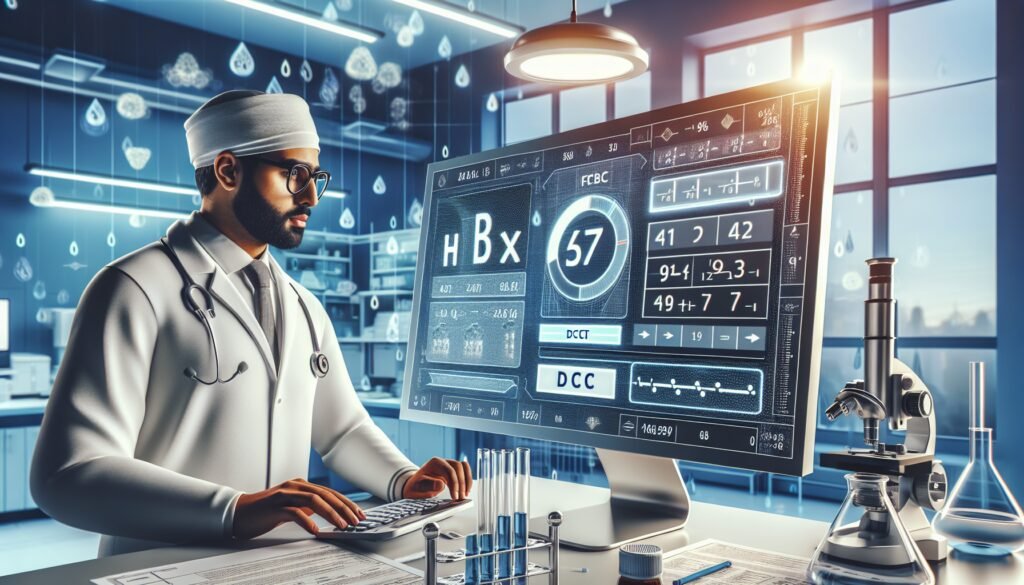
Understanding the HbA1c units conversion guide – DCCT to IFCC is critical for diabetes management, as it helps patients and healthcare providers track blood sugar control over time. The HbA1c test is a cornerstone in diabetes care, reflecting average blood glucose levels over a span of two to three months.
With different units being used across the globe, converting HbA1c values becomes essential for accurate comparison and treatment decisions. Let's delve into the significance of these units and how to effectively use an HbA1c conversion calculator to interpret your results.
What you\'ll find in this article?
- Why Did HbA1c Units Change?
- Getting Familiar With the HbA1c Unit Changes
- Are the New HbA1c Units Related to Blood Glucose Test Units?
- How Does HbA1c Differ From a Blood Glucose Test?
- Ifcc Standardization of HbA1c
- How to Use the HbA1c Units Converter
- Convert blood glucose to hba1c
- Blood sugar converter to hba1c
- Convert blood glucose mg dl to hba1c
- Hba1c conversion formula - HbA1c units conversion guide – DCCT to IFCC
-
Questions Related to the HbA1c Units Conversion
- What Are DCCT and IFCC Units for Measuring HbA1c? - HbA1c units conversion guide – DCCT to IFCC
- How to Calculate HbA1c IFCC? - HbA1c units conversion guide – DCCT to IFCC
- What Is the HbA1c Value for the IFCC? - HbA1c units conversion guide – DCCT to IFCC
- What Is a Normal HbA1c DCCT Level? - HbA1c units conversion guide – DCCT to IFCC
Why Did HbA1c Units Change?
The shift from traditional percent-based measurements (DCCT) to the International Federation of Clinical Chemistry (IFCC) units, represented in mmol/mol, was driven by the need for greater accuracy and standardization in HbA1c testing. This change ensures that diabetic patients around the world receive consistent and reliable readings, no matter where their tests are conducted.
Initially, the DCCT units were more commonly used, but they were based on less precise methodologies. As laboratory techniques evolved, the IFCC introduced a more precise reference method, leading to the adoption of new units.
The transition to IFCC units allows for a direct link to the actual amount of glucose bound to hemoglobin, offering a more standardized and direct reflection of a patient's glycemic history.








Getting Familiar With the HbA1c Unit Changes
Patients and healthcare providers need to understand the differences between DCCT and IFCC units to interpret HbA1c test results correctly. It's important to recognize that while the numbers may look different, they represent the same underlying measure of glucose control.
For those accustomed to the percentage system, it might take some time to get used to the new mmol/mol format. However, conversion tools have made this transition much smoother, enabling quick and easy translation between the two.
Becoming familiar with both sets of units is beneficial, especially when reviewing historical data or communicating with international healthcare systems that may still use the DCCT format.
The units used to express HbA1c percentages and blood glucose levels are different, which can sometimes lead to confusion. Blood glucose tests are typically reported in milligrams per deciliter (mg/dL) or millimoles per liter (mmol/L), depending on the country.
While HbA1c reflects longer-term glucose control, blood glucose tests provide a snapshot of glucose levels at a specific moment in time. Therefore, although related, the units are not directly convertible without a specific formula or tool such as an HbA1c to eAG conversion calculator.
Understanding this distinction is crucial for accurate monitoring and management of diabetes.
How Does HbA1c Differ From a Blood Glucose Test?
The HbA1c test measures the percentage of glycated hemoglobin in the blood, which is hemoglobin that has glucose attached to it. Unlike daily blood glucose tests, the HbA1c provides an overview of blood sugar levels over several weeks or months.
This test is essential for diagnosing diabetes and for monitoring how well a person is managing their blood sugar levels. It's an invaluable tool for adjusting treatment plans and reducing the risk of long-term complications associated with diabetes.
While a blood glucose test provides immediate feedback on a person's current blood sugar level, the HbA1c offers a broader picture, which is essential for long-term diabetes management.
Ifcc Standardization of HbA1c
The IFCC standardization of HbA1c aimed to harmonize testing methods worldwide, improving the accuracy and reliability of diabetes diagnosis and monitoring. This initiative established a reference method for laboratories to measure HbA1c, reducing variability and ensuring consistent results.
This global standardization effort has been critical for facilitating international research, enabling the comparison of clinical trial outcomes, and improving patient care by ensuring that HbA1c results are comparable no matter where the test is performed.
The adoption of the IFCC standard has also been instrumental in updating diabetes management guidelines and ensuring that patients receive the most accurate information about their condition.
How to Use the HbA1c Units Converter
Converting HbA1c values between the DCCT and IFCC units is simple with an online HbA1c units converter. Here's a step-by-step guide on how to use it:
- Input your HbA1c result in the format you have it (either % or mmol/mol).
- The converter will automatically calculate and display the equivalent value in the alternate unit.
- For a more comprehensive understanding, use the converter to also estimate the equivalent average blood glucose (eAG), which can provide additional insight into your glycemic control.
It's essential to use these tools regularly to ensure that you have the most accurate understanding of your blood sugar control and can make informed decisions about your diabetes management.
Convert blood glucose to hba1c
Understanding how to convert blood glucose levels to HbA1c can be crucial for diabetes management. HbA1c reflects the average blood glucose levels over the past two to three months, providing a broader view than daily glucose checks. This conversion allows patients to better understand their long-term control of blood sugar levels.
To convert blood glucose measurements to HbA1c, a commonly used formula is HbA1c (%) = (Average Blood Glucose (mg/dL) + 46.7) / 28.7. This formula estimates HbA1c based on the average glucose level, giving an approximate percentage of hemoglobin that is glycated. It's important to remember that this is an estimation and actual HbA1c can vary based on individual factors.
Regular monitoring of both blood glucose and HbA1c is essential for effective diabetes management. This dual approach helps to identify trends and make necessary adjustments in diet, exercise, and medication. Understanding the relationship between these two measurements can empower patients to take control of their health.
Healthcare providers often use these conversions to communicate with patients about their glycemic control. By translating blood glucose readings into HbA1c percentages, patients can grasp the implications of their daily numbers and make informed decisions about their lifestyle and treatment plans.
In conclusion, converting blood glucose to HbA1c provides valuable insights into an individual's overall blood sugar control. By utilizing established formulas and understanding their significance, patients can better manage their diabetes and work towards achieving their health goals.
Blood sugar converter to hba1c
The blood sugar converter to HbA1c is a valuable tool for individuals managing diabetes. It allows users to understand how their daily blood glucose levels translate into HbA1c values, which reflect average blood sugar over the past two to three months. This conversion is crucial for assessing long-term glycemic control.
To effectively use a blood sugar converter, one must input their average blood glucose readings. The converter typically utilizes established formulas to estimate the corresponding HbA1c level. This helps patients and healthcare providers make informed decisions about treatment and lifestyle adjustments.
Understanding the relationship between blood sugar levels and HbA1c is essential for diabetes management. A common formula used for conversion is HbA1c (%) = (Average Blood Glucose + 46.7) / 28.7. This equation provides a straightforward way to convert daily glucose readings into an HbA1c percentage.
Regularly using a blood sugar converter can empower individuals with diabetes to monitor their condition better. By keeping track of both blood glucose and HbA1c levels, they can gain insights into the effectiveness of their diabetes management strategies.
In conclusion, utilizing a blood sugar converter to HbA1c can enhance understanding and control over diabetes. It serves as a bridge between daily monitoring and long-term health outcomes, ensuring that individuals remain proactive in their diabetes care.
Convert blood glucose mg dl to hba1c
Converting blood glucose levels from mg/dL to HbA1c is essential for understanding long-term glucose control in individuals with diabetes. This conversion allows healthcare providers to assess how well a patient's blood sugar is managed over a period of time. The correlation between the two measurements helps in making informed treatment decisions.
The formula for conversion between average blood glucose (ABG) in mg/dL and HbA1c is quite straightforward. You can use the equation: HbA1c (%) = (Average Blood Glucose in mg/dL + 46.7) / 28.7. This formula provides a reliable estimate of HbA1c based on daily glucose levels.
Understanding this conversion is crucial, as it enables patients to monitor their diabetes control more effectively. For example, an average blood glucose level of 154 mg/dL corresponds approximately to an HbA1c of 7%. This information can motivate patients to maintain or improve their glucose management strategies.
Additionally, it is important to note that while conversion formulas provide estimates, individual factors such as hemoglobin variants can affect HbA1c readings. Therefore, regular monitoring and consultation with healthcare professionals are necessary to ensure accurate assessments and effective diabetes management.
In summary, converting blood glucose from mg/dL to HbA1c provides valuable insights into a patient’s overall health. This conversion not only facilitates better understanding of diabetes management but also encourages proactive steps in maintaining optimal blood sugar levels.
Hba1c conversion formula - HbA1c units conversion guide – DCCT to IFCC
The HbA1c conversion formula is essential for understanding the difference between the two main systems used to report hemoglobin A1c levels: DCCT and IFCC. The DCCT (Diabetes Control and Complications Trial) values are expressed in percentage, while the IFCC (International Federation of Clinical Chemistry and Laboratory Medicine) values are given in mmol/mol. To convert between these units, specific formulas are applied.
To convert an HbA1c value from DCCT to IFCC, the formula used is: (HbA1c % - 2.15) × 10.929. This calculation helps healthcare professionals and patients to easily interpret their blood glucose control across different measurement systems. It is critical for ensuring accurate monitoring and management of diabetes.
Conversely, to convert from IFCC to DCCT, the formula is: (HbA1c mmol/mol / 10.929) + 2.15. Understanding these formulas allows for seamless communication between patients and healthcare providers, facilitating better diabetes management strategies.
It is important to note that while both systems aim to measure the same underlying parameter, variations in the conversion can occur due to different laboratory methods and equipment. Therefore, consistently using the same unit of measurement is advised to avoid confusion when tracking a patient's HbA1c levels.
In summary, mastering the HbA1c conversion formula is vital for anyone involved in diabetes care. By being able to convert between DCCT and IFCC values, healthcare professionals can provide more accurate assessments and tailored treatment plans for their patients, ultimately improving health outcomes.
What Are DCCT and IFCC Units for Measuring HbA1c? - HbA1c units conversion guide – DCCT to IFCC
DCCT units, expressed as a percentage, reflect the proportion of hemoglobin that is glycated. This was the traditional format for the HbA1c test. On the other hand, IFCC units, expressed in mmol/mol, indicate the actual amount of glycated hemoglobin in relation to non-glycated hemoglobin, offering a more precise measurement.
The difference between these units is not just numerical but also reflects the evolution of scientific understanding and measurement accuracy in diabetes care.
How to Calculate HbA1c IFCC? - HbA1c units conversion guide – DCCT to IFCC
To calculate the IFCC unit value of HbA1c from the DCCT percentage, you can use a formula or, more conveniently, an HbA1c conversion calculator. These tools automatically convert the values based on established correlations between the two measurement systems.
It's crucial to use reliable and updated conversion tools to ensure the accuracy of the conversion, especially when using the results to make healthcare decisions.
What Is the HbA1c Value for the IFCC? - HbA1c units conversion guide – DCCT to IFCC
The HbA1c value for the IFCC is reported in mmol/mol and is derived from a precise reference method that measures the amount of glycated hemoglobin. The normal range for the IFCC is typically between 20-42 mmol/mol, but targets may differ based on individual health conditions and guidelines.
Understanding your IFCC HbA1c value in the context of your overall diabetes management plan is important for optimal control of the condition.
What Is a Normal HbA1c DCCT Level? - HbA1c units conversion guide – DCCT to IFCC
A normal HbA1c DCCT level is generally considered to be below 5.7%. Levels between 5.7% and 6.4% indicate a higher risk of diabetes, and a level of 6.5% or higher on two separate tests typically signifies a diabetes diagnosis.
It's important to note that normal levels may vary depending on the individual, and one should always discuss their HbA1c results with a healthcare professional to determine the appropriate action.









